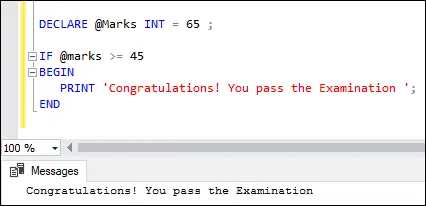Instrukcja IF jest częścią funkcji przepływu sterowania w SQL Server. Zwykle jest to oświadczenie decyzyjne w różnych językach programowania zwraca wartość na podstawie podanych warunków . Ta instrukcja wykonuje kod zapisany w bloku IF, gdy dany warunek ma wartość true, a gdy warunek ma wartość false, wówczas zostanie wykonana instrukcja ELSE.
Oświadczenie IF
Poniżej przedstawiono składnię ilustrującą użycie tej instrukcji w SQL Server:
IF boolean_expression BEGIN { statement_block } END W powyższej składni, blok_wyciągu w POCZĄTEK...KOŃC blok jest wykonywany, gdy Wyrażenie logiczne jest zadowolony z warunku. W przeciwnym razie blok ten jest pomijany, a sterowanie programem zostaje przeniesione do instrukcji znajdującej się po KONIEC słowo kluczowe. Powinniśmy wiedzieć, że jeśli wyrażenie zawiera a WYBIERAĆ oświadczenie, musimy to zrobić ująć je w nawiasy .
Przykład
Zobaczmy przykład, aby zrozumieć instrukcję IF bez bloku ELSE. Poniższy przykład wyświetli wynik, gdy warunek zostanie spełniony. W przeciwnym razie kontrola programu została przeniesiona do instrukcji znajdującej się po słowie kluczowym END, jeśli takie istnieje.
DECLARE @Marks INT = 65 ; IF @marks >= 45 BEGIN PRINT 'Congratulations! You pass the Examination'; END
Wykonanie instrukcji da poniższy wynik:

Teraz zademonstrujemy to poniżej ' Student' tabela zawierająca następujące dane:

Poniżej znajduje się kolejny przykład, który pobiera całkowity wynik wybranego ucznia z kl. Student' table w przykładowej bazie danych, a następnie wypisuje plik a wiadomość Jeśli to jest większa niż 400 .
BEGIN DECLARE @Total_Marks INT; SELECT @Total_Marks = total_marks FROM Student WHERE age>25; SELECT @Total_Marks; IF @Total_Marks > 400 BEGIN PRINT 'Congratulations! You pass the Examination'; END END
Otrzymamy poniższe dane wyjściowe:

Jeśli chcemy zobaczyć powyższy komunikat wyjściowy, powinniśmy kliknąć Wiadomości patka:

Instrukcja IF-ELSE
W rzeczywistym świecie musimy wykonać jakąś akcję, gdy warunek w instrukcji JEŻELI ma wartość PRAWDA lub FAŁSZ. W tym przypadku przydatna jest instrukcja IF…ELSE. Ta instrukcja wykonuje blok instrukcji ELSE, gdy warunek w klauzuli IF zostanie oceniony jako FAŁSZ.
Poniżej przedstawiono składnię ilustrującą użycie instrukcji IF ELSE w SQL Server :
IF expression BEGIN Statement block -- It executes when the IF clause expression is TRUE. END ELSE BEGIN Statement block -- It executes when the IF clause expression is FALSE. END
Przykład
Zobaczmy przykład, aby zrozumieć instrukcję IF z blokiem ELSE. Poniższy przykład wyświetli komunikat „ Gratulacje! Zdajesz egzamin ', gdy spełniony jest warunek JEŻELI. W przeciwnym razie wyświetl „ Poniosłeś porażkę! Więcej szczęścia następnym razem '.
DECLARE @Marks INT; SET @Marks = 65; IF @marks <45 begin print 'congratulations! you pass the examination'; end else 'you are failed! better luck next time'; < pre> <p>Executing the statement will give the below output. Here, the <strong>marks</strong> variable is <strong>65</strong> , and the <strong>condition (65<45)< strong> is not satisfied. Therefore, the message inside the ELSE block is displayed:</45)<></strong></p> <img src="//techcodeview.com/img/sql-server-tutorials/49/sql-server-if-else-5.webp" alt="SQL Server IF ELSE"> <p>We will get this output because the condition <strong>(65>45)</strong> is satisfied. Therefore, the message inside the IF block is displayed:</p> <img src="//techcodeview.com/img/sql-server-tutorials/49/sql-server-if-else-6.webp" alt="SQL Server IF ELSE"> <p>Now, we will demonstrate the IF ELSE statement on the above ' <strong>Student'</strong> table. In this example, we are going to check whether the student <strong>total marks</strong> is <strong>greater than or equal to 400</strong> or not as follows:</p> <ul> <li>When the IF condition is TRUE, we will get the student records whose total marks are greater than or equal to 550.</li> <li>If the condition is FALSE, we will get the student records whose total marks are less than 550.</li> </ul> <p>Here is the program:</p> <pre> DECLARE @Marks INT; SET @Marks = 600 ; IF @Marks >= 550 BEGIN SELECT id, name, gender, age, total_marks FROM Student WHERE total_marks >= 550 ORDER BY age ASC END ELSE BEGIN SELECT id, name, gender, age, total_marks FROM Student WHERE total_marks <550 order by age asc end < pre> <p>In this code, we have specified the <strong>@Marks</strong> variable to <strong>600</strong> , and the condition (600 >= 550) is satisfied. Therefore, we will get the output where student records whose total marks are greater than or equal to 550 are displayed.</p> <img src="//techcodeview.com/img/sql-server-tutorials/49/sql-server-if-else-7.webp" alt="SQL Server IF ELSE"> <p>If we changed the <strong>@Marks</strong> variable to <strong>500</strong> and the condition (500 >= 550) becomes false. Therefore, we will get the output where student records whose total marks are less than 550 are displayed.</p> <img src="//techcodeview.com/img/sql-server-tutorials/49/sql-server-if-else-8.webp" alt="SQL Server IF ELSE"> <h2>Nested IF ELSE Statement</h2> <p>Unlike other programming languages, we can nest an IF...ELSE statement inside another IF...ELSE statement in SQL Server. Let us demonstrate it with the following example:</p> <pre> DECLARE @age INT; SET @age = 6; IF @age <18 50 print 'you are underage'; else begin if @age < below 50'; senior cetizen'; end; pre> <p>In this example, we are going to check whether the <strong>age is underage, below 50, or senior citizen</strong> as follows:</p> <ul> <li>If the value of the <strong>@age</strong> variable is below <strong>18</strong> , it will print the person is <strong>underage</strong> .</li> <li>If the condition is FALSE, the ELSE part will be executed that has a nested IF…ELSE.</li> <li>If the value of the <strong>@age</strong> variable is under <strong>50</strong> , it will print <strong>below 50</strong> . Finally, if no condition is satisfied, it will print <strong>senior citizens</strong> .</li> </ul> <p>Here is the result:</p> <img src="//techcodeview.com/img/sql-server-tutorials/49/sql-server-if-else-9.webp" alt="SQL Server IF ELSE"> <p>This article gives a complete overview of how to use the SQL Server IF ELSE statement. Here we have learned:</p> <ul> <li>Variables are objects that serve as placeholders.</li> <li>The keyword BEGIN will be used to start a statement block, and the END keyword must be used to close it.</li> <li>The use of ELSE in an IF... ELSE statement is optional.</li> <li>It's also possible to nest an IF...ELSE statement inside another IF...ELSE statement. However, nesting an IF statement within another statement is bad practice because it makes the code difficult to read and maintain.</li> </ul> <hr></18></pre></550></pre></45>
